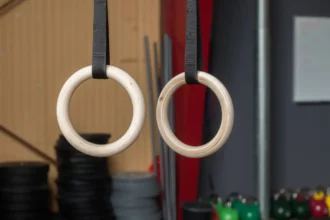Pull-ups are a staple exercise in many fitness routines, known for their ability to build upper body strength.
When it comes to biceps development, pull-ups can indeed be effective, though their impact varies based on the type of pull-up performed and the technique used.
How Pull-Ups Build Biceps
Pull-ups are a compound exercise that mainly targets the upper back muscles but also significantly works the biceps. Here’s how pull-ups help develop your biceps:
Muscle Activation During Pull-Ups
Pull-ups engage multiple muscle groups, including:
- Latissimus Dorsi (lats)
The lats are the primary muscles involved in pull-ups, responsible for adduction, extension, and internal rotation of the shoulder joint. Pull-ups heavily engage the lats as you pull your body upwards, with the muscle fibers contracting to lift and stabilize your torso.
- Biceps Brachii
The biceps are responsible for elbow flexion and forearm supination. During pull-ups, especially chin-ups and close-grip variations, the biceps play a significant role in pulling your body up to the bar. This makes pull-ups an effective exercise for bicep growth and strength.
- Trapezius
The trapezius muscle stabilizes and moves the scapula (shoulder blades). The upper and middle fibers of the trapezius are activated during the pulling motion, helping to stabilize the shoulder blades and assist in the upward movement.
- Rhomboids
The rhomboids retract the scapula, aiding in shoulder blade movement and stabilization. These muscles are engaged as you pull your shoulder blades together during the upward phase of the pull-up.
Mechanics of Muscle Growth in Pull-Ups
Muscle growth, or hypertrophy, during pull-ups involves several key mechanisms.
1. Mechanical Tension
Mechanical tension refers to the force exerted on muscles during contraction and stretching. It is a primary driver of muscle hypertrophy.
During pull-ups, especially with added weight or slow eccentric movements, the muscles are subjected to significant mechanical tension. This tension occurs in both the concentric (lifting) and eccentric (lowering) phases of the exercise.
High levels of tension recruit more muscle fibers, particularly type II (fast-twitch) fibers, which have a greater potential for growth.
2. Muscle Damage
Muscle damage refers to the micro-tears in muscle fibers that occur during intense exercise. This damage is a normal part of the muscle remodeling process.
Pull-ups, particularly those with a slow eccentric phase, induce muscle damage by placing a controlled strain on the muscle fibers. The body repairs these micro-tears by fusing muscle fibers together, which increases the size and strength of the muscles.
3. Metabolic Stress
Metabolic stress is the accumulation of metabolic byproducts (such as lactate, hydrogen ions, and inorganic phosphate) in the muscles during exercise. This stress contributes to muscle hypertrophy through various mechanisms.
High-repetition pull-ups or those performed with limited rest can create significant metabolic stress, leading to cell swelling and increased anabolic hormone production. Techniques such as drop sets or supersets also enhance metabolic stress.
Most Effective Pull-Ups for Biceps
Pull-ups are a versatile and effective exercise for building biceps, especially with certain variations. Here are the best types of pull-ups for maximizing bicep growth:
1. Chin-Ups
Grip: Underhand (palms facing towards you), shoulder-width apart.
Chin-ups are one of the most effective pull-up variations for bicep growth. The underhand grip places the biceps in a more favorable position to handle the load, significantly engaging the biceps throughout the movement.
Besides targeting the biceps, chin-ups also engage the back, shoulders, and core, providing a comprehensive upper body workout.
How to Perform:
- Grab the pull-up bar with an underhand grip, hands shoulder-width apart.
- Hang with arms fully extended and engage your core.
- Pull your body upwards until your chin is above the bar.
- Lower yourself back down in a controlled manner.
2. Close-Grip Pull-Ups
Grip: Overhand, hands placed closer than shoulder-width apart.
The closer grip reduces the involvement of the lats and shifts more of the workload to the biceps. This variation effectively targets the biceps along with the forearms and shoulders.
How to Perform:
- Grasp the bar with a close overhand grip, hands about 6-8 inches apart.
- Hang with your arms fully extended and core tight.
- Pull your body up until your chin clears the bar.
- Lower yourself slowly and repeat.
3. Neutral Grip Pull-Ups
Grip: Palms facing each other.
This grip allows for balanced activation of the biceps, brachialis, and forearms. The neutral grip can be easier on the wrists and elbows, making it a good option for those with joint concerns.
How to Perform:
- Grab the pull-up bar with palms facing each other.
- Hang with arms fully extended.
- Pull yourself up until your chin is level with the bar.
- Lower yourself back down slowly.
4. Gymnast Pull-Ups (Bicep Pull-Ups)
Technique: Focus on a curling motion rather than a strict vertical pull.
Gymnast pull-ups, often referred to as gymnast curls, are a variation of the traditional chin-up or pull-up. The primary difference lies in the technique: instead of pulling your body straight up to the bar, you perform a curling motion, engaging the biceps more intensively.
How to Perform:
- Hang from the bar with an underhand grip, shoulder-width apart.
- Visualize the bar as a barbell and curl your body up to the bar.
- Keep your elbows in a fixed position to focus the movement on your biceps.
- Lower yourself back down with control.
How to Maximize Bicep Engagement in Pull-Ups
Maximizing bicep engagement during pull-ups involves specific techniques that enhance muscle activation and growth. Here are some detailed strategies:
1. Slow Eccentric Movements
The lowering portion of a pull-up is key for muscle growth. By slowing down this phase, you keep your biceps under tension longer, which boosts muscle growth. This technique helps break down more muscle fibers, leading to bigger gains when your muscles recover and rebuild.
Implementation:
- Start at the Top: Begin with your chin above the bar.
- Controlled Descent: Slowly lower your body in a controlled manner, taking about 3-5 seconds to reach the bottom.
- Full Range of Motion: Ensure your arms fully extend at the bottom to maximize the stretch on the biceps.
2. Isometric Holds
Isometric holds involve maintaining a static position at the top of the pull-up, where the biceps are fully contracted. This technique keeps constant tension on the biceps, enhancing muscle endurance and strength.
Implementation:
- Pull to the Top: Perform a pull-up and hold when your chin is above the bar.
- Hold Steady: Maintain this position for 5-10 seconds, focusing on keeping the biceps engaged.
- Controlled Descent: After the hold, lower yourself slowly back to the starting position.
3. Adding Weight
Once proficient with bodyweight pull-ups, adding external weight can further challenge the biceps and stimulate hypertrophy through progressive overload. This can be done using a weight belt, weighted vest, or holding a dumbbell between the feet.
Implementation:
- Select Appropriate Weight: Start with a manageable weight to maintain proper form.
- Perform Weighted Pull-Ups: Execute the pull-up with the added weight, ensuring full range of motion.
- Progress Gradually: Gradually increase the weight as your strength improves.
Final Thought
Overall, while traditional bicep exercises like curls are beneficial, adding pull-ups and their variations to your workout routine provides a functional, compound movement that effectively builds bicep strength and size. Using proper form and gradually increasing the difficulty will give you the best results for bicep growth.






